Currently Browsing
Teaching Resources
How to Refocus a Difficult Class
- 13 December //
- Posted in Teaching Resources //
- Tags : classroom management
- Comments Off on How to Refocus a Difficult Class

Even the most seasoned teachers have encountered a class they just can’t reign in. If you’re currently facing a troublesome group of students, don’t give up hope. If you find yourself asking how to refocus a difficult class, you’ve come to the right place. Here are five simple methods for taking back control of your classroom, while still maintaining your sanity and professionalism.
#1 Take advantage of the support systems in place
There are various school support personnel in every school district and many of them can provide you with valuable feedback. From guidance counselors to school psychologists and social workers, there is usually someone who could offer advice on how to work with a specific student, or suggest methods that work with a particular issue. Also, you may not be the only one dealing with these issues. Talk to other teachers who may teach the same students as you to see what strategies they use that work.
Parents and guardians are part of the support systems too. The best phone call you make will be to parents and guardians. Communication with parents is the most effective method for eliminating bad behavior in the classroom. Make phone calls whenever necessary, and remember to call parents back when the behavior improves. You’re more likely to get them on your side if you take time to note the positive.
#2 Don’t use threats to change negative behaviors
It’s tempting to scream,“If this doesn’t stop right now, every single one of you will be assigned detention today!” or “The next person who utters even one word will get a zero on this test!” Threats don’t go over well with students and are nearly impossible to enforce as a teacher. Don’t succumb to the ease of idle threats. Instead, pause before making the threat and think of other strategies that might work in the moment.
#3 Follow your code of conduct
Students should be aware of the teacher’s or the school’s code of conduct. A code of conduct should outline the consequences for specific behaviors in the classroom. If tardiness is the reason you’re losing control of your class, follow the written code of conduct to correct the misbehavior. This shows students there are direct effects for their actions, leaves a paper trail of your decision making, and often triggers an automatic phone call home. Using an already published and readily available list of consequences also eliminates accusations of unfairness or favoritism.
#4 Engage ringleaders in positive behaviors
When a classroom veers out of control it can often be traced to a few ringleaders who influence the entire class. Those students should be dealt with directly, including all the steps listed above. They should also be given a chance to be a positive member of the classroom. Give them responsibility and go out of your way to compliment positive behaviors. This tells them the consequence that resulted from their poor behavior is not personal and there is ample opportunity to gain attention for the right reasons.
#5 Mix it up and engage the class with your lessons
The best recipe for classroom management is a good lesson plan. Look inward and ask yourself: Are my lessons stale? Can I find materials that are more engaging? Are the students being asked to be passive or active learners? Trying something different can be daunting because no one likes to experiment with the unknown in an already difficult situation, but it is our professional responsibility to give our students the best chance at success, even if that means changing what has worked in the past. One way to reinvigorate your lessons is to use engaging materials, such as graphic organizers or text analysis worksheets, which are part of Help Teaching’s free printable worksheets collection, to encourage higher level thinking and more active student participation.
A difficult class is never a lost cause. Follow these steps to ensure that you’ve exhausted all of your options so you – and your class – have the best chance at success for the entire school year. Read 5 Rules for the First Day of School for more advice on how to create a welcoming classroom.
If you enjoyed this read, you might also like what KidsKonnect has to say. Check out their articles today.
6 Activities to Promote Computer Science Education
- 2 December //
- Posted in Teaching Resources //
- Tags : activities for children, code, STEM
- Comments Off on 6 Activities to Promote Computer Science Education
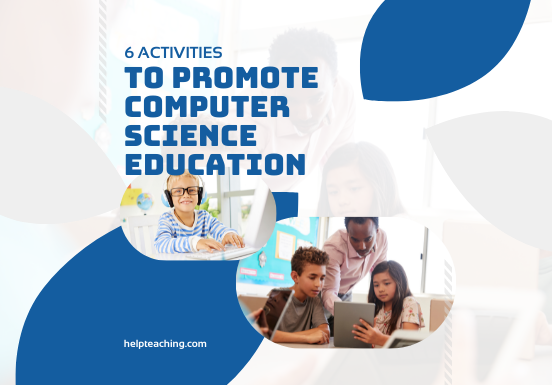
Since 2013, Computer Science Education Week has been held during the second week of December. This week is designed to make students and teachers more aware of computer science and the importance of building computing skills at an early age. While enrolling all students in regular coding and other computer science classes may be the ideal solution, you can still take small steps to encourage students to take notice of computer science and help them discover how much fun it can be. Here’s our pick of activities to promote computer science education.
Participate in an Hour of Code
In 2014, the Hour of Code gained a lot of publicity when President Obama sat down to join students as part of the event. This year, and all year long, you can also participate in an hour of code. Organize your own Hour of Code event at your school or join up with an existing group. If you’re not sure of what you’re doing, search for local volunteers to come work with your students during the event. For a less formal option, simply have your students complete one of the coding tutorials available through Code.org where they code with popular characters from Star Wars, Minecraft, or even Anna and Elsa from Frozen.
Don’t be afraid to go beyond an Hour of Code either. Many different apps and websites offer a series of lessons designed to teach students how to code or to think in ways that are related to the language of coding. A few of them to try in your classroom include:
Elementary
- Kodable – a fun app that comes with an extensive coding curriculum
- ScratchJr – a free app that teaches kids to think like a coder while completing fun tasks
- Tynker – another provider of an Hour of Code resources featuring brands and characters kids love
Secondary
- Hopscotch – an app that allows kids to make and publish their own games
- CodeCombat – an online, multiplayer game that requires kids to write code to play
- Kodu Game Lab – a visual programming tool that kids can download to create games
Hold a Computer Science Career Day
Students often hear that there are tons of job in the tech industry, but do they know what those jobs look like? Invite parents and other community members to your school for a Computer Science Career Day. Your speakers can rotate among classes to share what their jobs are like or they can set up tables in booths and talk to students as they approach them. If you can’t find individuals to come to school, then have students research different tech jobs or companies and share their findings with the class.
Show a Video
Take some time to show kids a video related to computer science. There are tons of Ted Talks related to technology that could inspire kids to consider a career in computer science. A few videos you might want to use include:
- The Math Behind Basketball’s Wildest Moves
- The First Secret of Design is Noticing
- Toy Tiles that Talk to Each Other
- The Future of Flying Robots
- How a Driverless Car Sees the Road
- New Bionics that Let Us Run, Climb, and Dance
- A 12-Year-Old App Developer
Have Fun with a MaKey MaKey Kit
While a MaKey MaKey kit does not involve a lot of coding, it does encourage kids to think outside of the box and imagine the cool things they can do when they combine computers with everyday objects. You can turn students’ experiments with the kit into writing assignments, science experiments, marketing proposals, and other educational activities.
Connect Computer Science to Students’ Interests
Your students may not be interested in computer science, but they may be interested in playing football, playing with their toys, or drawing and coloring. Chances are they don’t realize how much computer science can play a role in these activities. For example, it takes a lot of technology to take video of a football game, freeze it, and move it around on the screen. Give students the task of researching how technology plays a role in their favorite hobbies. They may discover that coders help create 3D models of their favorite toys or that they can create some amazing art with lines of code.
Get Away from the Computer
While learning how to code can benefit students, thinking in the language of coding is even more important. By promoting logic and creative thinking skills, you can give students the mental skills they’ll need to be successful in a computer science field. CS Unplugged offers a large selection of activities designed to help kids develop these critical thinking skills. These include tasks such as learning about The Turing Test and discovering how difficult it is for computers to draw lines and circles.
For more resources to help you bring Computer Science into the classroom, check out Code.org and the Computer Science Education Week website. If you use some of these activities in your classroom, share them to Facebook or Twitter with the hashtags #CSEdWeek and #HourOfCode.
How to learn about and celebrate Hanukkah
- 29 November //
- Posted in For Parents, Teaching Resources //
- Tags : hanukkah, ideas, teacher resources, ultimate guide, winter
- Comments Off on How to learn about and celebrate Hanukkah
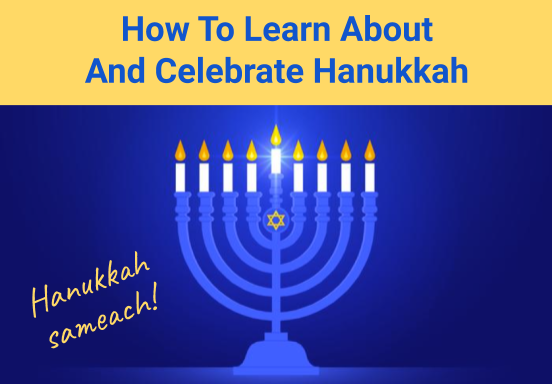
Whether you’re Jewish or want to teach your students more about this popular observance, we unpack the holiday and list activities and worksheets that you can use to celebrate Hanukkah!
Although it doesn’t rank among the most important of the Jewish holidays, Hanukkah is one of the most widely observed Jewish celebrations. This eight-day “Festival of Lights” illuminates what is, for many in the northern hemisphere, the darkest, coldest season of the year.
Hanukkah brings light, joy, and warmth to our homes and communities. The holiday’s central ritual of lighting candles of a menorah each day literally brings light to the darkness. Metaphorically, the presence of light is reflected in an emphasis on charitable donations and, for some Jews, a commitment to social action and social justice.
Celebrate Hanukkah by Learning it’s Origins
Hanukkah (sometimes spelled Chanukah) recalls the second-century BC victory of a small group of Jewish rebels (led by Judas Maccabeus and his brothers, known together as “the Maccabees”) over the armies of the Seleucid Empire. The Maccabees seized control of Judea and founded the Hasmonean dynasty, which ruled for over 100 years.
Hanukkah means “dedication” in Hebrew, because the major accomplishment of the Maccabees was a rededication of the Jerusalem Temple, which for many years had been used for the worship of Persian and Greek deities. The Maccabees were also responsible for expanding the boundaries of Judea and reducing the influence of what they considered pagan Hellenism.
The miracle of Hanukkah, which is reflected in the lighting of candles and eating foods prepared in oil, comes from the story that when the Maccabees rescued the Temple from the Seleucids, they could only find one small cruse of oil that bore the seal of the priests. All the others had been profaned. There was only enough oil to light the Temple’s menorah for one day. Instead, by a miracle, the oil lasted eight days and nights – long enough for the priests to prepare and consecrate new oil.
Why does the date of Hanukkah change every year?
Hanukkah always starts at sundown on the 25th day of the month of Kislev on the Hebrew calendar. All days on the Jewish calendar start at nightfall. The secular date of Hanukkah changes every year because the Hebrew calendar is based on the lunar cycle. Hanukkah can occur anytime between November 28th and December 26th. This year it begins at sunset on December 10, 2020. In 2021, Hanukkah begins on the evening of November 28. The annual festival of lights happens in 2022 starting on December 18.
Free and Premium worksheets and activities to celebrate Hanukkah
Help Teaching has surveyed many Hanukkah-related educational resources for you to download and use. Here are the highlights:
Our own Hanukkah-themed resources include:
- FREE Hanukkah matching
- FREE Hanukkah fill in the blanks
- FREE Read aloud story of Hanukkah
- PRO Hanukkah tens and ones
There are many others listed in our Winter Holidays worksheet collection that cover ELA, math, sciences, games and puzzles, and more.
Fun Hanukkah activities
Hanukkah is a special time to enjoy with friends and family, and fun games and activities are part of the tradition.
- Hanukkah Mad Lib: Children will have fun spinning the dreidel and doing some Hanukkah Mad Libs which will provide hours of laughs while helping kids expand their knowledge of parts of speech. If you don’t want to buy the book, make your own Mad Libs, or try this free one from My Jewish Learning.
- Listen and Learn: Older children and adults will enjoy listening to stories of the season on “Hanukkah Lights” from National Public Radio carried on stations across the country. For more than 15 years, NPR has offered original stories inspired by the Jewish festival of lights. Hosted by NPR’s Susan Stamberg, and Murray Horwitz, each year Hanukkah Lights marks the age-old Jewish celebration with contemporary fiction. Previous years’ episodes are available free and on-demand.
- Get cooking: Food is a delicious part of Hanukkah. Holiday treats include latkes, sufganiyot, bimuelos (fried dough puffs) and keftes de prasas (leek patties). You and your kids will enjoy watching the PBS program “Sara’s Weeknight Meals: Jewish Holidays” airing on many stations across the country. Find out where and when or watch on YouTube. Sara Moulton serves up two traditional Hanukkah dishes that are tricky to prepare. Step by step, she takes us through the process, starting with Braised Brisket, and on the side, her Aunt Rifka’s recipe for matzo balls they call ‘flying disks’. Sara and her nephew visit the farm and food incubator Stone Barns in Westchester, New York, to get fresh winter vegetables for her Root Vegetable Latkes.
- Games: These involve making your own simple cutout crafts from construction paper or card stock
- Play “Pin the Candle on the Menorah”. Have your kids draw and color a giant menorah on posterboard, then make cutout candles to stick on while blindfolded. Kids take turns until all eight candles are placed.
- Make a “tick, tack, toe” game out of dreidels and menorahs using hand drawn and cut out pieces and a hand-drawn game board. Many crafts stores sell foam Hanukkah stickers which can be used as game pieces
- Crafts:
- Make a Star of David and Menorah sculptures out of popsicle sticks and a little glue. Color the sticks beforehand. You could use pipe cleaners instead of sticks.
- Organize a plate of fruit into the shape of a menorah
- There are more great craft ideas listed here.
You will find 101 Hanukkah activities for kids of all ages at care.com.
Printable worksheets
Printable worksheets are a great way to engage students in learning a new topic. KidsKonnect is a growing library of high-quality, printable worksheets for teachers and homeschoolers. They have loads of Hanukkah Facts and Worksheets that include a fact file and activities for a range of ability levels.
Hanukkah online and multi-media resources
My Jewish Learning is offering a live community candle-lighting over Zoom every night of Hanukkah.
ReformJudaism.org has a platter full of Hanukkah resources, videos, recipes, and activities for all ages.
Making your classroom more holiday-inclusive
This can be a challenge, particularly in today’s pluralistic society. Here are a few ideas for celebrating holiday ideas upon which most families can agree no matter their faith or absence of it.
- Move the spotlight off the individual student and onto others by underscoring the spirit of giving
- Students can study figures from history who spent their lives focused on the needs of others
- Children can also make gifts for each other, their parents/guardians, or other family members
- Have your students taking part in a food drive or toy drive as a method to teach about the spirit of giving
- Create multicultural celebrations
- Acknowledging the various beliefs of students in your classroom can extend beyond the month of December
- Celebrations of the major holidays of various faiths could occur throughout the year at the appropriate time
- Why not make a commemoration of a holiday an opportunity to give a history lesson on the development of the holiday?
- You can have your students investigate the cultural significance of the celebration
- Learning about various faiths does not signify an endorsement by you or the school of that belief system
- Limit celebrations to foundational ideas
- A vital part of multiculturalism is to teach children about various points of view
- By focusing on common ideas such as charity, celebrations become more universal without the added layer of religious debate
- Maintain anti-bias goals
- Holiday celebrations are a great way to have students examine the similarities and differences of our shared society
- Shedding light on these differences, and celebrating them in a non-judgmental manner, is a great lesson for children to learn
- Finally, keep parents/guardians informed
- Let the parents/guardians of your students know ahead of time what and how religious holidays will be commemorated
- In this way, parents can nuance what you are teaching in the classroom with their own beliefs
- Some parents may want their child to opt out of the holiday celebration, so be prepared with an appropriate response which honors their beliefs
- Let your school administrator know what you will be doing with regard to religious holidays, and follow the school’s guidance on the issue
Teachers and administrators may find this article helpful when assessing options for instruction about religions in U.S. public schools.
Hanukkah may be a Jewish holiday, but this festival of lights can be celebrated by all.
Hanukkah sameach!
Image source: Hanging Stars Vectors by Vecteezy
Ultimate Guide to Educational Toys for Kids
- 25 November //
- Posted in For Parents, Teaching Resources //
- Tags : gifts, parent resources, ultimate guide
- Comments Off on Ultimate Guide to Educational Toys for Kids

Did you know it’s possible to have fun and learn at the same time? While it’s great for kids to play with toys, their young minds are at the prime stage for taking in information and learning new skills. The solution? Toys that allow kids to learn while they play. This year when you shop for holiday and birthday gifts, opt for something with educational value.
Need help finding ideas? We’ve rounded up some of the top educational toys for kids.
Disclosure: HelpTeaching partnered with the companies of some our top picks to provide items for a giveaway, but all items were chosen for their quality educational value.
|
JUMP TO:
|
Babies | Toddlers | Preschoolers |
| Early Elementary | Upper Elementary | ||
| Pre-Teens | Teens |
Babies
Even though babies won’t remember whether you bought them a gift for Christmas or their birthday, sometimes you still want to get them something. Instead of adding another stuffed animal to their collection, try one of these options.
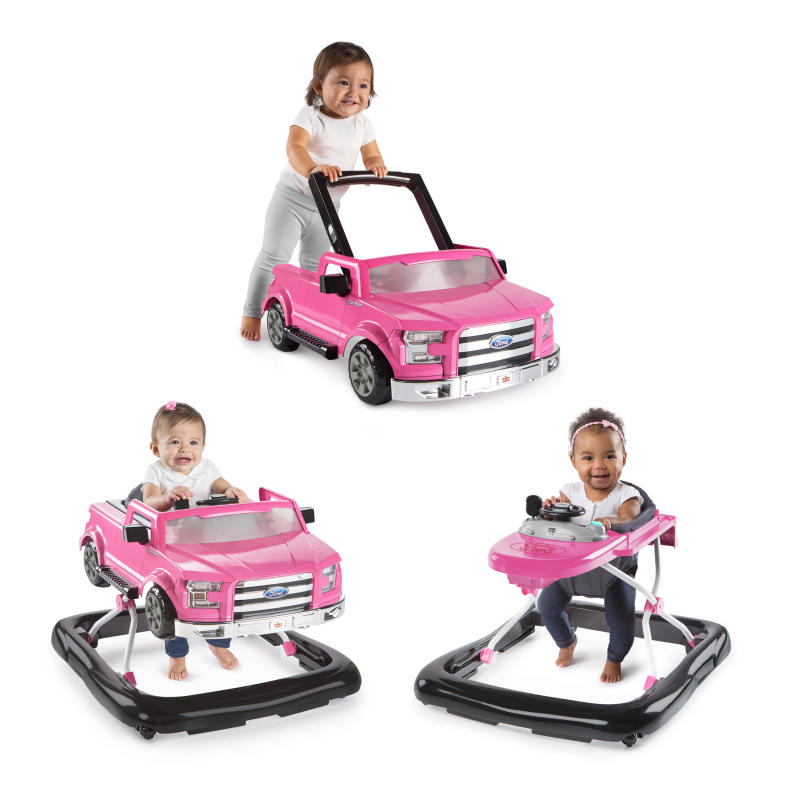
TOP PICK: 3 Ways to Play Walker – Ford F-150 – Never underestimate the power of observation. This walker allows babies to explore the world around them in three different ways, including a normal walker and push-behind mode. The steering wheel and authentic truck sounds and lights make the walker even more adorable.
Baby’s First Blocks: Nothing beats a classic shape sorting toy for babies and toddlers. Baby’s First Blocks from Fisher-Price features a handy tub to collect the shapes and a handle for carrying it. Babies and toddlers will learn to grab, manipulate, and match the shapes.
Skip Hop Activity Mirror: Mirrors are great toys for babies. They allow them to explore the world around them and also begin to recognize their own face. This mirror from Skip Hop is just one of many baby mirrors that can be attached to the seat of a car or the bar of a stroller for babies to enjoy.

Munchkin Mozart Magic Cube: Babies love music and this magic cube combines music with lessons in cause and effect and tempo to create a fun learning experience for babies. They can press different parts of the cube to add instruments to the orchestra and see lights flash with the tempo of the music.
Go Car: This car comes with a handle to make it easy for babies to hold on to it and control the way it moves. It also glides smoothly on different surfaces, helping babies begin to learn about the concept of movement.
What’s Inside Toy Box?: With the What’s Inside Toy Box, babies begin to learn that objects have names and also build motor skills as they reach in and pull out objects or put objects back in. Additionally, this toy can help teach object permanence.
All About Me Personalized Photo Book: Babies can learn the names and faces of loved ones, pets, and other special people or places in their lives with this photo book. Parents can insert photographs in protected compartments so babies can flip through and look at them.
Toddlers
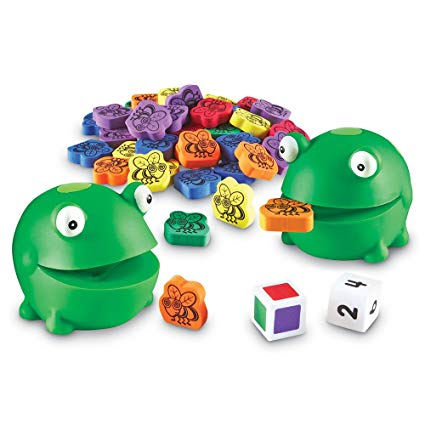
TOP PICK: Froggy Feeding Fun – Little kids can boost their fine motor skills, learn their colors, and practice their counting skills with this fun frog feeding game. Simply roll the dice and feed the frogs the correct flies. Note that the fly pieces may present a choking hazard so kids should be supervised while playing.
Start-Up Circuits: Toddlers who enjoy playing with switches will enjoy these toys that help them begin to understand how circuits work. Simply flip the switch to make each object work.
Wooden Building Blocks: Blocks are a favorite for toddlers because they help them build motor skills and begin to understand geometrical concepts. This set from Pidoko Kids features 50 colorful blocks in different shapes and comes with a container for carrying them all.
Personalized Name Puzzle: One of the first things a toddler learns how to spell is his/her name. Help develop that skill and help your toddler start learning how to complete puzzles with a personalized name puzzle.
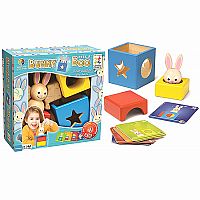
Color Discovery Boxes: Color Discovery Boxes help toddlers learn their colors and begin to categorize objects. Each box contains multiple objects to represent the color. Mix the objects up and have toddlers sort them and put them back where they belong.
Bunny Peek a Boo: This fun game helps toddlers learn about prepositions and object placement. They must look at the cards and try to create the scene with the bunny and various blocks. Parents are encouraged to give clues and talk about where the bunny is. For example, “The bunny is behind the box.”
Learn the Alphabet Dough Mats: You can print out and laminate your own dough mats or you can buy these handy mats which feature uppercase and lowercase letters. These help kids learn letters and build fine motor skills.
Size and Sequence Farm Puzzles: Size and Sequence Farm Puzzles have toddlers put the puzzle pieces in order by size. This set of puzzles helps them learn how to organize objects from smallest to largest.
Dress-Up Career Set: Toddlers can learn a lot from dressing up, especially when they dress up to represent different careers. With this set, your toddler can pretend to be someone else nearly every day of the week.
Seek A Boo: Seek A Boo is a fun game designed to get toddlers and preschoolers moving and help them learn how to categorize objects. Basically, it works like a game of “I Spy” where kids must find a circle that meets a particular description. Adults and kids can take turns coming up with questions.
Preschoolers
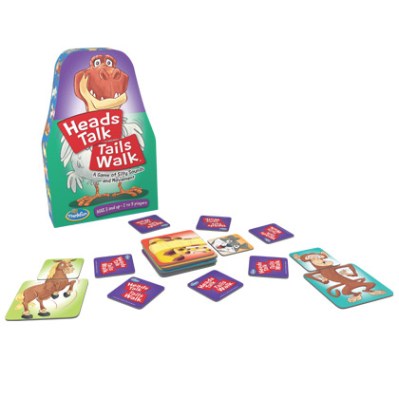
TOP PICK: Heads Talk Tails Walk – ThinkFun’s game of silly sounds and movement has kids try to match hidden head cards to the correct bodies. If the body parts don’t match, kids have to try and act out their crazy new animals.
Yeti Forgetti Memory Game – This hide and peek memory game gets kids in on the action. Cards direct kids to shuffle the igloos and try to find the locations of the different yetis in the game while watching out for the evil snow crab for a twist on a classic shell game.
Bear Counters: Bear Counters and counting cubes can be used by preschoolers in a variety of ways. Not only are they good for counting practice, but they can also be used for creating patterns and measuring.

Fun Express Happy Kids Hand Puppets: This adorable set of hand puppets features kids from different ethnic backgrounds. It’s great to include with a puppet theater and to use to act out social stories to help get preschoolers thinking about their actions and emotions.
Toss Across: If you’re looking for a fun game to get kids moving, try Toss Across, a game that helps kids practice their throwing skills and learn about patterns while playing a game of tic tac toe.
Periodic Table Blocks: Make block play a little more educational by having kids learn the elements of the periodic table at the same time. These square blocks are great for building and also feature the names, symbols, and atomic numbers of various elements.
Mosaic Mysteries Pattern Puzzle: Kids can build fine motor skills and create patterns when they play with the Mosaic Mysteries Pattern Puzzle, an activity that features connecting tiles to create a mosaic.
Early Elementary
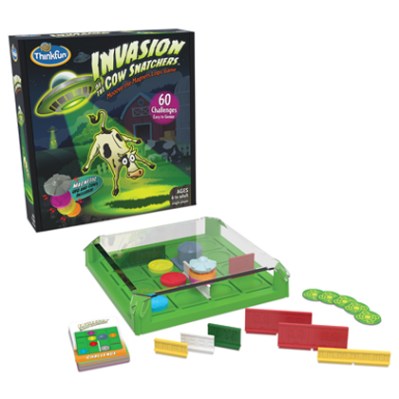
TOP PICK: Invasion of the Cow Snatchers – Kids can build their logic and problem-solving skills with this exciting STEM game from ThinkFun. While the game can be enjoyed by kids as young as 6, even older kids, teens, and adults will enjoy trying to solve some of the genius-level challenges.
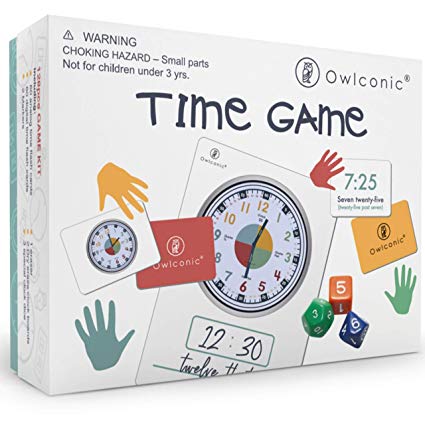
TOP PICK: Owlconic Telling Time Teaching Game – For teachers and homeschool parents looking for new ways to help kids learn to tell time, this telling time game is exactly what you need. It helps kids make connections between digital and analog time while also working on memory skills and fractions.
Teaching Talking Cash Register: This cash register is a favorite of kids because it offers many functions. Kids can play store or open a real store and the cash register will help them add up totals and calculate change. It also features a fun scanner.
Melissa and Doug Magnetic Human Body: Kids can learn the different parts of the human body by taking them on and off the wooden form. It’s a great, non-gory way for kids to begin to explore what makes up the body.
Magformers: Magformers feature fun tiles that connect to one another. Kids can use them to build unique structures.
Magnetic Science: Magnetic Science contains 38 pieces to help kids explore magnets and their various uses.

Precision School Balance: With a balance, kids can practice weighing items and comparing different weights. For example, is a carrot heavier than four quarters?
Dive into Shapes: Using a series of rods and balls, kids can build their understanding of geometry as they try to recreate the shapes on the cards.
Sum Swamp: Sum Swamp is a fun game that helps kids build their addition and subtraction skills.
Paper Airplane Conversion Kit: With the help of a grown-up, kids can use this kit to make a variety of paper planes and see how long they fly electronically.
Beaker Creatures: Learning Resources has created a fun science toy where kids can conduct experiments to reveal hidden creatures. Kids simply pop a reactor pod into the chamber, complete the steps, and discover a surprise. They learn about the scientific method and follow directions at the same time.
Upper Elementary

TOP PICK: Squishy Human Body – SmartLab Toys helps kids explore the body through this unique model. The body includes 21 vital organs, bones, and body parts, as well as a 24-page anatomy book and other resources to help kids explore the model.
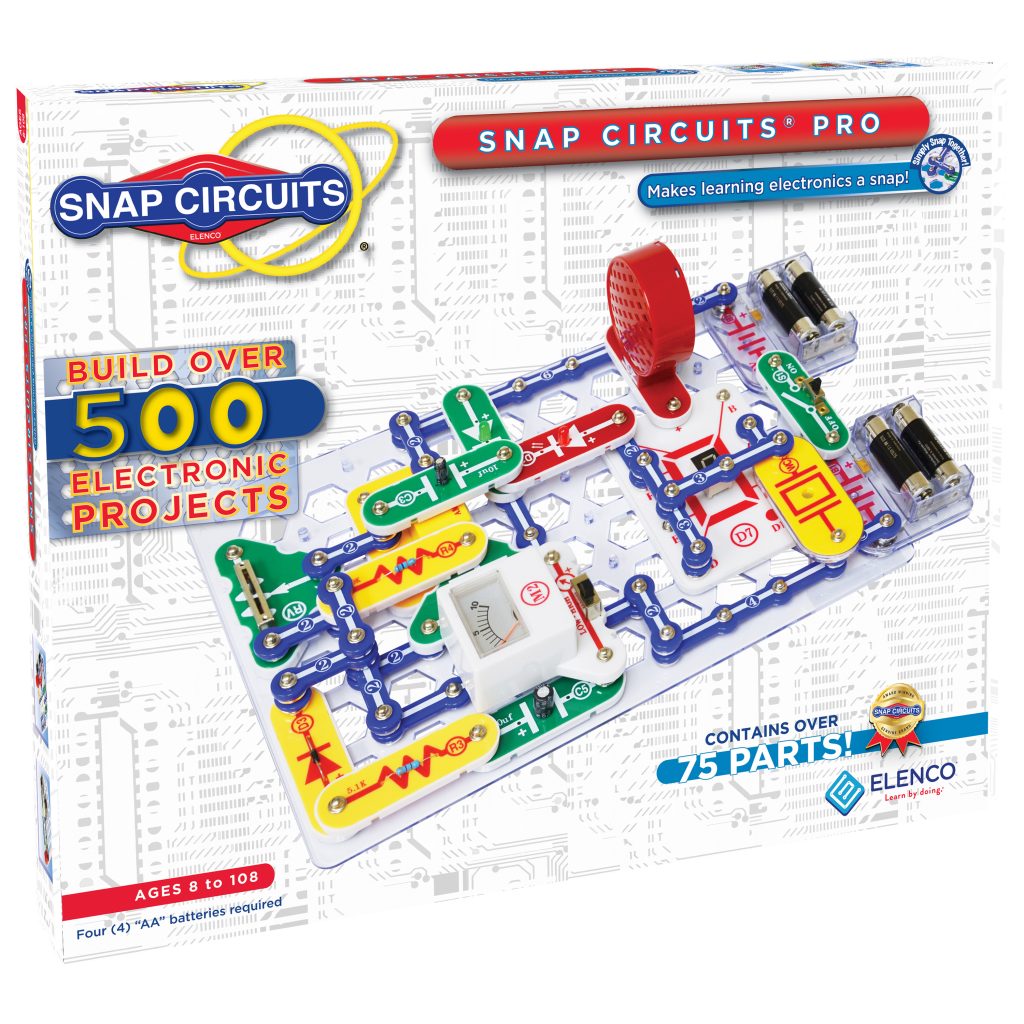
TOP PICK: Snap Circuits Pro – With over 75 snap-together parts and 500 exciting projects to complete, kids can learn all about electronic circuits and the basics of electricity. This kit is great for building STEM, problem-solving, and logic skills.
Adopt an Animal: Start teaching your child about giving back and becoming more aware of the world by adopting an animal. The kit comes with a certificate and a stuffed animal.
Kiwi Crate offers maker kits for kids up to age 16. Try Doodle or Tinker Crate for ages 9-16 and Kiwi for ages 5-8. Sign up for a monthly subscription box. Each box comes with fun STEM and STEAM activities for kids.
Tin Can Robot: Take an ordinary tin can and turn it into something cool with the Tin Can Robot kit. Using this kit, kids can build their own robot.
Star Wars Death Star Electronic Lab: Star Wars fans will love the challenge of the Death star Electronic Lab which has them connect circuits to help bring the Death Star to life.
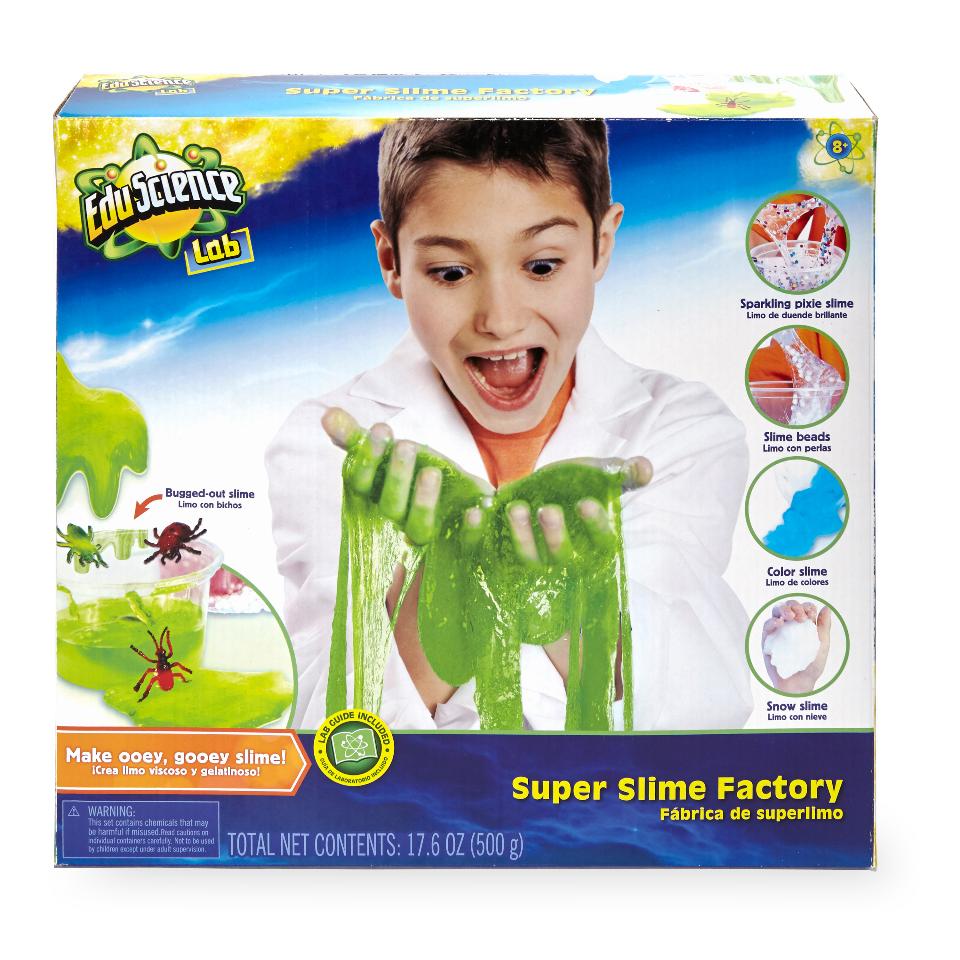
Super Slime Factory: Slime is all the rage these days and the Super Slime Factory gives kids the chance to make their own slime while learning a bit about the science that goes into the process.
Qwirkle: Qwirkle is a fun game with a dominoes-like feel. Kids must match the shapes and colors, but they also have to use a bit of strategy to win the game.
Keva Contraptions: With Keva, kids can learn about engineering and geometry. This set allows kids to build unique contraptions and also comes with two balls. Perhaps kids will use them to make an epic marble run.
Create a Maze: With the Create-a-Maze set, kids are tasked with re-creating the maze on a card and then trying to get a ball through the maze.
Klutz LEGO Chain Reactions Craft Kit: This book and LEGO set helps kids learn how to build simple machines and put them to use, introducing them to the laws of physics at the same time.
For preschoolers through upper elementary school students, you can also put together a craft kit, full of supplies, such as googly eyes, stickers, craft sticks, and glitter glue, to make a variety of crafts and to encourage kids to use their imaginations.
Pre-Teens
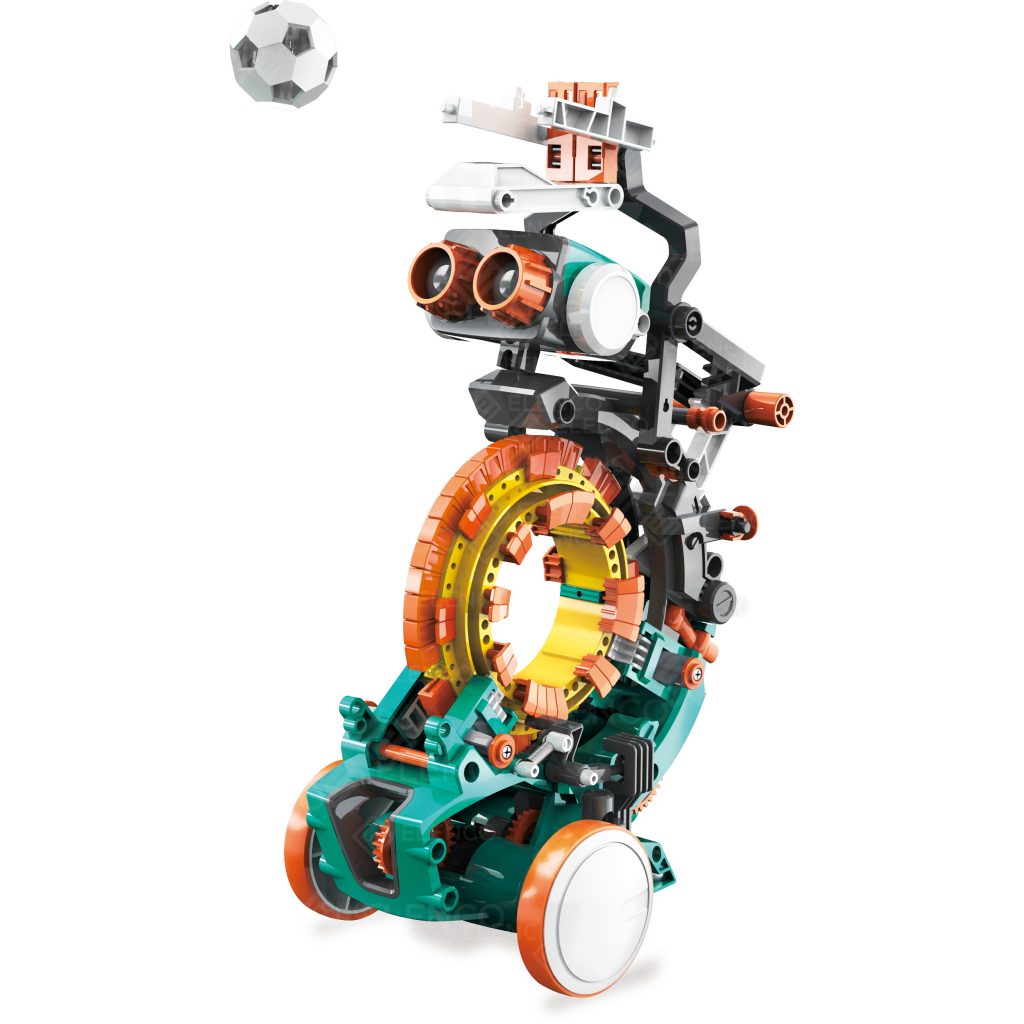
TOP PICK: Elenco Teach Tech Mech-5 Coding Robot – This STEM coding robot introduces kids and teens to the principles of mechanical engineering. They work with their robot to get it to perform tasks such as kicking, throwing, lifting, and even drawing.
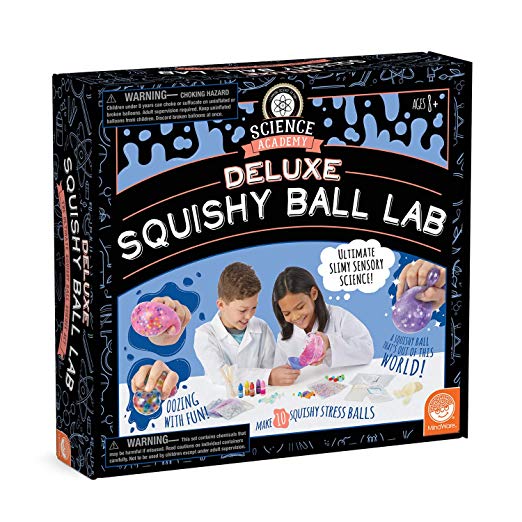
TOP PICK: Science Academy Deluxe Squishy Ball Lab – Encourage kids and tweens to get their hands dirty and make their own squishy stress balls. The kit is great for boosting STEM skills and getting in some sensory fun.
Kano Computer: Pre-teens who enjoy coding and working with electronics, but are not quite ready to work on a full-fledged computer will appreciate Kano Computer, which allows them to build their own mini-computer.
Perfume Maker: A lot of science goes into the creation of perfume. This set allows pre-teens to make their own scents while learning at the same time.
Spa Soaps Kit: Let pre-teens make their own spa soaps, and then use them to host a spa party for their friends. Better yet, they can package their soaps and give them as gifts to others.
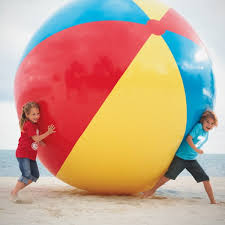
Giant Inflatable Ball: Encourage pre-teens to get outside and be active by purchasing a giant inflatable ball. They can make up their own fun games to go with the ball too.
Boxed Book Sets : If you know a pre-teen loves to read or has a favorite series, consider purchasing a boxed set. The Giver trilogy by Lois Lowry is a great set to consider.
Eco-Friendly Bean Bag: Instead of a normal bean bag, opt for an eco-friendly bean bag. The gift will teach pre-teens about being more environmentally conscious.
Build Your Own Pinball: Kids and teens can learn about engineering by building their own pinball game with this fun set.
Teens

Displates: Give teens a unique gift that teaches them to value creativity and different art forms. Displates come in different styles and relate to interests such as popular movies and TV shows or musical instruments.
Ion: A Compound Building Game – Know a teen struggling with chemistry? Find some STEM fun and refresh that chem knowledge with a fun game that has kids and teens collect cards and build chemical compounds.
Quadcopter: What’s more fun than a drone? A drone with a camera. Teens can make their own videos and take pictures as they fly their drones.
Marvel Puzzle: Have a superhero fan? Give them a superhero puzzle so they can enjoy some of their favorite skills and they put their puzzle-solving skills to the test.

Codenames Disney: Codenames is a fun word association game. Purchase the Disney version or another themed-version and play it with your teen.
Die Cast Spirograph: Spirograph may seem like a kids’ toy, but this version of the classic drawing kit is super sleek. Teens may find creating their own spiral shapes relaxing.
Games: World of Puzzles: Purchase a subscription to a magazine such as Games: World of Puzzles. This fun magazine includes many different puzzles for teens and adults to solve.
Game of Phones: Teens are always on their phones. Get them to interact with one another with this fun game which has them use their phones to send messages and complete challenges.
My Cinema Lightbox: A lightbox is a fun way to get teens to write. They can come up with creative messages or even practice spelling vocabulary words.
In addition to the gifts listed above, consider purchasing apps and other digital gifts for teens or giving them a gift card to purchase music and apps for their phones or tablets.
Do you know of any must-have educational gifts for kids or teens? If so, we’d love to hear your ideas. Share them in the comments!
*This list may contain affiliate links and some companies provided products for review, but all views expressed are our own.
If you enjoyed this read, you might also like what KidsKonnect has to say. Check out their articles today.
4 Ways to Make a Holiday-Inclusive Classroom
- 24 November //
- Posted in Teaching Resources //
- Tags : teaching tips
- Comments Off on 4 Ways to Make a Holiday-Inclusive Classroom

Every teacher wants their classroom to be a place of joy, harmony, and inclusion, particularly during the winter holiday season. But with students of many faiths and cultures represented in today’s classrooms, it can sometimes be tricky to stay sensitive to everyone’s needs and step around the pitfalls of stereotyping and tokenism. Keep reading for our suggestions on how to make a holiday-inclusive classroom.
Teachers are at the vanguard of diversity education, so it’s our job to balance awareness, representation, and sensitivity when it comes to winter holiday celebrations in the classroom. These four key principles will help you develop your own strategy for holiday celebrations that engage students from a wide variety of cultures.
Holiday-inclusive Classroom Tip #1: Don’t Assume, Stereotype, or Tokenize
First and foremost, remember that holiday activities will often require care and thought toward equitability because of how they bring real-world traditions into the classroom. That can make a great opportunity for fun and interesting learning, but its benefits must be equitable.
How to pull off this balancing act? The first step is to check your assumptions and privilege. Don’t assume that a student celebrates any particular holiday based on their ethnicity or heritage. Likewise, don’t assume that everyone celebrates a winter holiday. Some students’ religious traditions may not have winter holidays or any holidays at all, and many will likely celebrate the same holiday in different ways.
One good way to get started is to open up a discussion to any student who wants to talk about their celebrations or traditions, keeping in mind that not all children will be comfortable talking about theirs. Remember that students shouldn’t be expected to be experts on the holidays they or their families celebrate. Student-led discussions of different celebrations can be great, but avoid putting any student on the hot seat to talk about or explain a particular tradition.
Holiday-inclusive Classroom Tip #2: Build Diversity into Your Lesson Plans
Good holiday lesson plans should celebrate differences. A unit on different holiday celebrations, for example, can provide some fun and interesting lesson opportunities. The holiday season is the perfect time to bring in guest speakers to talk to the class about how they celebrate holidays, since many students will be eager for a change of pace, and speakers can often provide interesting and in-depth insights to add to discussions. Parents or community leaders make great guest speakers, and some will probably be eager to share their traditions.
If you want to examine certain traditions but can’t fit in guest speakers, try reading books or watching films or YouTube videos as part of your investigations into how different cultures celebrate. For older students, breaking the class into groups to learn about and report on various holiday traditions can be a good way to create student interest and sharpen research skills. If interesting and diverse activities are available, field trips to community holiday events can be another excellent option.
Holiday-inclusive Classroom Tip #3: Think Outside the Usual Holiday Cliches
There’s nothing wrong with reindeer, Santa hats, and sugar cookies, but try to diversify your decorations and not focus them on a single holiday. At the same time, be careful about using symbols from cultures you’re not familiar with—do your research first and make sure you’re not using them in an offensive or inappropriate way. When in doubt, it’s best to politely ask someone with knowledge of the specific cultural tradition.
Soliciting student input on decorations or letting students hang their own crafts can offer a lot of great possibilities to let kids express themselves and feel represented in the classroom. Holiday STEM projects offer more great ideas since they often focus on things like winter weather that can be examined outside of a cultural or religious context. (Plus, they often use interesting and fun tools like student microscopes.)
In classes with a strong multicultural focus, one idea is to make the winter holidays a single piece of a rolling year-round investigation into holidays from many different traditions. This can be a good way to include students whose traditions don’t have any winter holidays, or for whom winter holidays aren’t a focal point of the year.
Tip #4: Consider Forms of Inclusion Outside of Religion and Culture
There are many ways to create a diverse and harmonious classroom besides acknowledging religious differences. The holidays are a great time to focus on what brings us together, and that means paying special attention to students with a full range of physical, cultural, social, and emotional needs. Consider factors such as:
- Dietary restrictions. Some traditional western Christmas food, for example, contains peanuts and other foods that may not be acceptable to students whose traditions include dietary rules.
- Emotional and social needs. Holidays can be an emotionally stressful time for many students, so it’s important to be able to point students toward the necessary resources.
- Needs of neurodivergent students and students with disabilities. The hustle and bustle of holiday activities can be difficult and overstimulating for students with some conditions, so make sure that diverse learners are getting the support they need.
Socioeconomic differences are another area that you may need to be particularly careful about addressing during the holidays. Questions about giving and receiving gifts can create uncomfortable moments for students from disadvantaged backgrounds, so be prepared to steer class discussions away from these topics if they come up, or to offer support to students who need it.
Cheryl Stevens is the Community Relations Specialist for AmScope. She oversees all company-wide outreach programs and initiatives. Her passion in life is helping others see the value in and implement STEM programs for children at an early age.
Further reading:
Learn about and Celebrate Hanukkah
Alternate Thanksgiving Traditions
Non-Spooky Halloween Activities
If you enjoyed this read, you might also like what KidsKonnect has to say. Check out their articles today.
Alternative Thanksgiving Traditions
- 19 November //
- Posted in For Parents, Teaching Resources //
- Tags : thanksgiving
- Comments Off on Alternative Thanksgiving Traditions
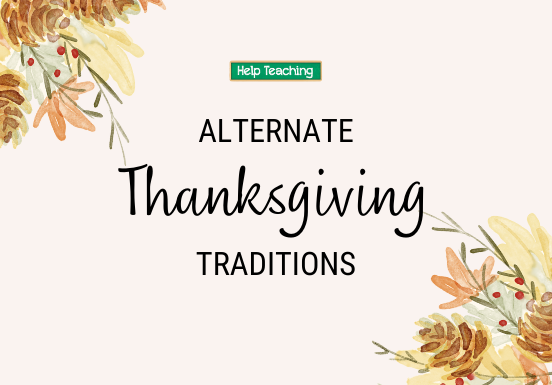
Whether you don’t have family nearby or are tired of the traditional turkey and stuffing, this is the year to try something new. From celebrating friends to participating in a 5K, there are many different ways to celebrate this Thanksgiving. Who knows? These alternative thanksgiving traditions could become your or your children’s traditions for years to come.
Here’s our list of Alternative Thanksgiving Traditions:
Celebrate Friendsgiving
Instead of shelling out hundreds of dollars to travel home or eating a TV dinner alone, gather together some friends for a Friendsgiving. A Friendsgiving is typically celebrated on the day before or the day after Thanksgiving, but you can also celebrate it on the actual day. The goal is to gather together with friends and enjoy a meal together.
A traditional Friendsgiving works similar to a potluck. One friend agrees to host and provide the turkey, chicken or ham. The other guests bring side dishes and desserts. If you’re not much of a cook, store-bought dishes are completely acceptable. You could even all go in together and purchase a full Thanksgiving dinner from your local grocery store or favorite restaurant.
For a unique take on a Thanksgiving meal, try a progressive dinner where a different friend hosts each course of the meal. This works particularly well if you all live close together. If no one has the space to host, head to a local diner or a restaurant like Denny’s (as declared in Tim Allen’s The Santa Clause, they’re always open).
Give Back to Others
Instead of eating at home on Thanksgiving, spend some time giving back to others. You can go the traditional service route and sign up to serve Thanksgiving dinner at a local soup kitchen or try something a little different. Giving back also teaches kids an important lesson about the value of serving others and may help them realize they have a lot to be thankful for. Some ways to give back to others on Thanksgiving include:
- Deliver food boxes or turkey dinners to people in need
- Collecting holiday gifts for children
- Put together care packages to send to members of the military
- Send cards to people you miss
- Visit a local nursing home
- Provide a treat to the staff at a local hospital
- Go to a restaurant and leave your server a large tip
- Clean out your cupboards to gather food for a local food pantry
- Contact a local college and offer to host students who stayed on campus during the holidays
Get Fit
On Thanksgiving morning, thousands of people gather to participate in “Turkey Trots” around the United States. These 5Ks have become a Thanksgiving tradition of their own. Gather some friends together and enter the race together or run solo and meet new friends along the route. Many 5Ks also have special fun runs or walks, so kids can join in the fun too. If you’re not a fan of running, you can always walk the 5K or volunteer to help out with the race in another way. When the race is over, treat yourself to a hearty Thanksgiving meal.
If you’re missing your family’s annual touch football game, organize one of your own. Meet your friends at a local park or advertise the game on a local events page so others without family in the area can join you.
Have a Movie Marathon
Thanksgiving is a big day for movie releases. Head to your local movie theater and spend the day hopping from theater to theater to enjoy them all. Just be sure you purchase a ticket for each movie. If you prefer a cheaper option, invite some friends to your house for a Christmas movie marathon or a showing of “A Charlie Brown Thanksgiving.” If kids are included, pull out all of your old holiday favorites, such as “Rudolph the Red-Nosed Reindeer” and “Frosty the Snowman.”
Go International
Many other countries celebrate their own versions of Thanksgiving throughout the year. Introducing elements of other cultures can also turn itno a mini-geography lesson for kids. Consider adopting one of these traditions for Thanksgiving:
- In Jewish culture, some families build a hut from branches called a Sukkot. Then they eat a meal beneath the hut.
- In China, families enjoy mooncakes, filled flaky pastries. The cakes were often used to deliver secret messages.
- In Korea, families honor the deceased. They hold a memorial service and occasionally visit a graveyard before feasting on Songpyeon.
- In Liberia, chicken and mashed cassavas replace turkey and mashed potatoes on the Thanksgiving table.
- In Ancient Rome, citizens celebrated Ceres, the goddess of corn. Ceres is also where we get the word cereal, so perhaps you could incorporate some sugary cereal into your Thanksgiving meal.
However you decide to celebrate Thanksgiving this year, take some time to write down what you’re thankful for. One thing is for sure – we’re thankful for you!
Do you have any alternative Thanksgiving traditions? Share them in the comments!
Further Reading for Alternative Thanksgiving Traditions
15 Engaging and Eduational Acitivities for Fall
If you enjoyed this read, you might also like what KidsKonnect has to say. Check out their articles today.
10 Fun Facts for Geography Awareness Week
- 13 November //
- Posted in For Parents, Fun Facts, Teaching Resources //
- Tags : geography, social studies
- Comments Off on 10 Fun Facts for Geography Awareness Week
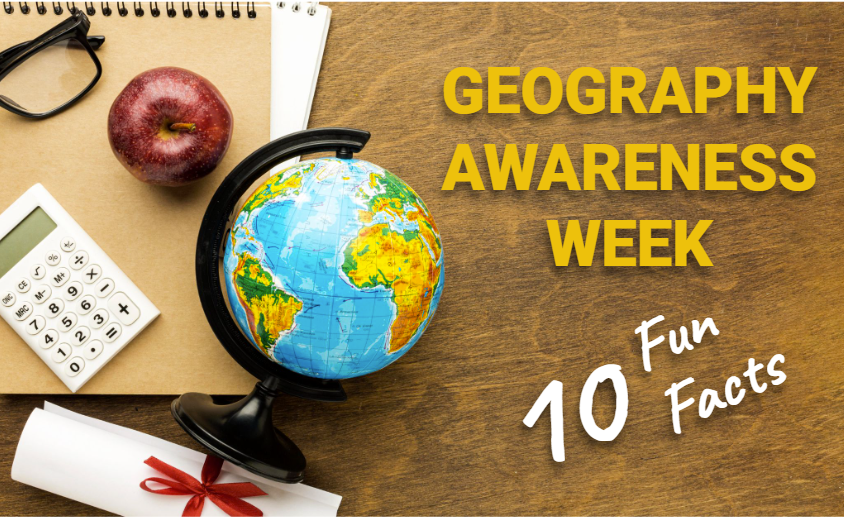
November 11-15 2024 is Geography Awareness Week.
Geography is an integral part of any Social Studies class. Making connections between a region’s geographic features and its history and culture can broaden students’ understanding of history. Some facts about geography will not only add flavor to a social studies unit but will also wow the students with unexpected answers and fun visuals.
Did you know…
#1. The smallest country in the world is Vatican City at only 0.2 square miles. The headquarters of the Catholic Church is located entirely in the city of Rome. Vatican City isn’t just the smallest country in land area, it is also the smallest country by population. Only about 600 people live there permanently, almost all of whom are clergy or members of the Swiss Guard, responsible for protecting the Pope.
#2. Unsurprisingly, the largest country in the world is Russia. What you may not know is Russia, with an area of 6,592,735 square miles, is almost twice the size of the second largest country in the world Canada, which comes in at 3,855,081 square miles. Over 60% of the land in Russia is forest, while over 4000 miles of the nation is tundra.
#3. Brazil is 11% larger than the contiguous 48 states of the United States of America. As a matter of fact, Brazil is the fifth largest country in the world. It is so big, that all of non-Russian Europe could fit inside of its borders!
#4. Asia is the largest continent in land area in the world. It is larger than North and South America combined! More people live in Asia (over 4 billion) than the rest of the world’s continents combined (almost 3 billion).
#5. The most common city name in the United States is Franklin, with 31. There are 26 cities in the world with a single letter as its name, two of which are located in America: B, Ohio and Y, Alaska. The original name of Los Angeles was El Pueblo de Nuestra Señora la Reina de los Ángeles del Río de Porciúncula. Translated in English it means The Town of Our Lady the Queen of Angels of the Porciúncula River.
#6. Africa includes 54 countries and over 2000 languages spoken. There are over 500 languages in Nigeria alone! The most widely spoken language is Hausa, which is the first language of over 35 million Africans and another 15 million people in other parts of the world.
#7. Canada contains over 300,000 islands, some of which are available for purchase for less than $1 million. The largest of these islands include Vancouver Island and Newfoundland.
#8. About 90% of the world’s population lives in the Northern Hemisphere. The only Southern Hemisphere nations that contain more than 50 million people are Indonesia and Brazil, at 227 million and 192 million, respectively.
#9. The Amazon rainforest represents more than half of the world’s rainforests and produces more than 20% of the world’s oxygen supply, contains 20% of all of the world’s plants and birds, and 10% of the world’s mammal species. 10% of the forest has been lost to agriculture in the last 50 years, with some forecasting the loss of the entire rainforest by 2030.
#10. The color red appears on the most national flags with 155. White is a close second with 144, and green is a distant third with 97. Purple appears in only six flags. Some national flags are almost identical due to a shared history. For example, blue, white, and red are common color combinations in Slavic nations, and many African nations use red, yellow, and green.
Use these facts as an introduction to a fun Geography Awareness Week lesson that can include a Fun Fact Scavenger Hunt. Ask your students to locate silly and surprising facts about each continent.
What other fun geography facts do you know? Leave them in the comments section! Be sure to visit HelpTeaching.com and try our free geography worksheets.
If you enjoyed this read, you might also like what KidsKonnect has to say. Check out their articles today.
8 Reasons Why I Teach Banned Books… and You Should Too
- 15 September //
- Posted in For Parents, Teaching Resources //
- Tags : books, language arts
- Comments Off on 8 Reasons Why I Teach Banned Books… and You Should Too
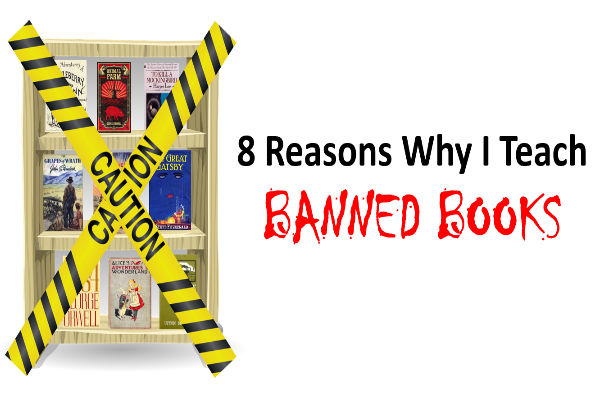
It seems like every year a new book makes the news for being challenged or banned by a school. Books that have been banned run the gamut from Mark Twain’s Huckleberry Finn to The Holy Bible. While some parents and teachers have legitimate concerns, others have less valid reasons (a library patron in Toronto, Canada wanted to ban Hop on Pop because it encouraged children to use violence against their fathers). Regardless of whether books contain controversial content, they should still be accessible to students. Here are eight reasons why I teach banned books and why they should be accessible to students.
Why teach banned books: They Challenge Students to Consider Alternate Viewpoints
As a parent, your first instinct is often to shield your children from things you don’t want them to see, but you can’t hide the world from your children forever. Banned books are often challenged because they contain controversial content or don’t mesh with adults’ beliefs, but that doesn’t always mean they’re bad. Instead of simply banning a book that contains an alternate viewpoint, use the book as an opportunity to safely expose students to that viewpoint. While reading the book, use reading response activities to discuss what’s controversial about it and why people might disagree with the actions or viewpoints held in the book. If you’re a parent whose child has to read a book for school that you don’t agree with, read the book with your child and talk to him/her about the content. Explain to your child why you don’t agree with it and encourage your child to share his/her thoughts too.
They Introduce Students to Diverse Characters
Often children live in their own little world where their friends and family members largely think and act like they do. While there are some exceptions to this rule, most children don’t get the opportunity to experience people and places that aren’t familiar to them. Many books have been banned throughout history because they contain diverse characters that children may not have encountered before. For example, the book Nasreen’s Secret School: A True Story from Afghanistan was challenged because the main character says a prayer to Allah in the book and the picture book And Tango Makes Three was challenged because the main characters are two male penguins who raise a chick together.
It’s important to remember that reading a book with diverse characters doesn’t mean you support those characters’ lifestyles or thoughts. Reading books with diverse characters can help students understand the different types of people that exist in the world and help them better prepare to interact with those people when they encounter them.
They Take Students Out of their Comfort Zone
Why are most books banned? Some of the most common reasons are because they include:
- racial themes
- alternative lifestyles
- inappropriate language
- unpopular religious views
- sexual or violent content
- unpopular political views
- references to witchcraft or the occult
- characters doing drugs or smoking
All of these reasons for banning books have one thing in common: they make people uncomfortable. It’s not fun to feel uncomfortable. It’s not fun to read something that takes you out of your comfort zone or challenges you to look at a situation differently, but it happens a lot in life and it’s bound to happen to children at one point or another. Should third graders be required to read books that contain excessive violence or sexual references? No. Should an eleventh or twelfth grader? Maybe. Because the eleventh or twelfth grader is about to enter a world where these issues will appear and what better place to practice being taken out of your comfort zone than in the safety of the classroom or your own home?
They Teach Valuable Lessons
In addition to taking children out of their comfort zones, banned books can often teach valuable lessons about identity, tolerance, or even freedom. For example, the book The Art of Racing in the Rain teaches readers a valuable lesson about the grieving process. The book The Working Poor: Invisible in America teaches a lesson about the real problems the working poor in America face. Brave New World teaches students about the extremes of passion and offers a bleak view of the future that students can connect to the future of the world. The Adventures of Huckleberry Finn has been banned numerous times its use of the n word, despite being regarded as one of the most valuable pieces of American literature.
They Can Be Interpreted in Multiple Ways
A book that is banned in one school or district may be perfectly acceptable in another. Take the case of Hop on Pop. One person in Toronto thought it advocated violence against fathers, but how many others have read the book and seen something completely different. What about the book And Tango Makes Three? Are children likely to see it as more than a story about a family of penguins? You could write a book with nothing offensive in it and, as a adults, we are often more likely to find offensive content than children.
They May Be Banned for Silly Reasons
Sometimes this also leads to books being banned for silly reasons. Did you know Shel Silverstein’s A Light in the Attic was once banned in an elementary school because it encouraged children to break dishes instead of dry them? The popular Harriet the Spy was once banned because Harriet is a spy and being a spy means that she occasionally lies and gets into mischief. Are You There God? It’s Me, Margaret was banned because it talked about a girl getting her period. Brown Bear, Brown Bear, What Do You See? by Bill Martin was banned because an author with the same name wrote a book about Marxism. Before you turn down a book because it has been banned, consider the reason it was banned. You may realize you were avoiding a book for no good reason at all.
They Are Often Great Books
Frankly, no one takes the time to ban a bad book. Not usually anyway. Books become banned because they become popular and fall into the hands of a diverse group of people. At some point, they’re bound to offend one of those people. Some of history’s greatest authors – Toni Morrison, Mark Twain, F. Scott Fitzgerald, Judy Blume – have written books that have been banned. By refusing to teach or let children read banned books, you’re often causing them to miss out on great writing.
They Promote Free Speech
But at the end of the day, the main reason to teach banned books is because books should never be banned in the first place. If you live in the United States, you know that one of the greatest freedoms you have is the right to free speech. Banning a book suppresses the author’s right to free speech and also suppresses students’ right to access media. Yes, a book may be inappropriate for a particular age group or it may contain controversial content, but banning books is a form of a censorship, the same censorship people decry in third world countries, the same censorship that is warned against in books like Fahrenheit 451:
“Black people don’t like Little Black Sambo. Burn it. White people don’t feel good about Uncle Tom’s Cabin. Burn it. Someone’s written a book on tobacco and cancer of the lungs? The cigarette people are weeping? Burn the book. Serenity, Montag. Peace, Montag. Take your fight outside. Better yet, into the incinerator. Funerals are unhappy and pagan? Eliminate them, too. Five minutes after a person is dead he’s on his way to the Big Flute, the Incinerators serviced by helicopters all over the country. Ten minutes after a man’s speck of black dust. Let’s not quibble over individuals with memoriams. Forget them. Burn all, burn everything. Fire is bright and fire is clean.”
The solution to handling books that contain content someone doesn’t like isn’t to ban them. Instead, teachers and parents can use these books as a learning tool and discuss them with children in a safe environment. That doesn’t mean you have to read all controversial books, but it does mean you shouldn’t avoid everything just because someone says it’s no good.
If you enjoyed this read, you might also like what KidsKonnect has to say. Check out their articles today. For worksheets related to literature, check out our library or create your own tests!
Hispanic Heritage Month 2025 – Reading List for K-12
- 6 September //
- Posted in For Parents, Teaching Resources //
- Tags : literature, reading list
- Comments Off on Hispanic Heritage Month 2025 – Reading List for K-12

Hispanic Heritage Month (Sep. 15 – Oct. 15) is all about celebrating the contributions of Hispanic and Latino people to the United States. There’s no better way to celebrate Hispanic contributions and culture than through literature! Whether you’re looking for a book for a preschooler or a novel for a teenager, there are many amazing books written by Hispanic and Latino authors. Not sure where to start? We’ve highlighted a few of our favorites.
Pre-K through 2nd Grade
Abuela by Arthur Dorros
Imagine what life would be like if you could fly. In this fun picture book, Rosalba flies around Manhattan with her grandmother and learns a lot about life along the way. The story mixes English and Spanish words and helps kids learn about Hispanic culture.
Gracias Thanks by Pat Mora
What are you thankful for? No matter what language you speak, there are many things to be thankful for. Kids are challenged to find things they are thankful for, just like the young boy in this simple picture book by one of the best-known Hispanic authors for children.
Nino Wrestles the World by Yuyi Morales
Nino is a spectacular wrestler and can defeat all of the greats. Kids will love the exciting illustrations and sound words used throughout the books. Parents will love the Spanish words and pronunciation guides.
3rd through 5th Grade
Esperanza Rising by Pam Munoz Ryan
Pam Munoz Ryan is one of the best-known Hispanic authors for this age group and Esperanza Rising is one of the best-known Hispanic novels for kids. This story follows a young girl as she loses her father, moves to the United States, and loses her social status, all while discovering herself.
Return to Sender by Julia Alvarez
This book discusses cross-cultural friendships and keeping hold of your heritage while trying to assimilate. It follows the relationship between a young farm boy whose parents hire migrant workers to help keep their farm afloat. This novel has won many awards.
My Name is Maria Isabel by Alma Flor Ada
Every child goes through a phase where they must discover who they are and stand up for themselves. In this novel, Maria’s teacher wants to call her Mary, but Maria is a name that holds a lot of significance. It follows Maria and her family as they learn how to balance their heritage with their American life.
6th through 8th Grade
The Dreamer by Pam Munoz Ryan
Pablo Neruda is a famous Hispanic poet and The Dreamer offers a fictional take on his life. This award-winning novel tells the tale of a Chilean boy who goes on to become a famous poet despite having an incredibly negative father. It is a very motivational read for middle school.
Baseball in April and Other Stories by Gary Soto
Gary Soto has written numerous coming-of-age stories for children and young adults. This is one of his best-known collections and a great read for pre-teen and teenage boys. The collection, which has also won numerous awards, including the ALA Best Book for Young Adults, shares stories from Soto’s life growing up in California, and shows not only a Hispanic experience, but an experience all boys can relate to on some level.
I Lived on Butterfly Hill by Marjorie Agosin
This award-winning novel tells the story of Celeste, an eleven-year-old girl from Chile who is sent to live with her aunt in the United States. Not only does she have to learn how to navigate life in the United States, she must also come to terms with what is going on in her home country and worry about her parents who are still there.
9th through 12th Grade
House on Mango Street by Sandra Cisneros
This is one of the quintessential story collections that every student should read. The coming-of-age book follows Esperanza Cordero as she grows up and learns to connect her Latino culture with her desire for something better. It also includes the popular short story Eleven.
How the Garcia Girls Lost Their Accents by Julia Alvarez
This novel has won numerous awards and has been hailed as a “new classic” for the twenty-first century. It tells the tale of the four Garcia sisters who flee the Dominican Republic and must learn to start their lives again in America. Each one has a different experience, but all are connected.
Cuba 15 by Nancy Osa
Violet Paz does not know a lot about her Latina heritage and does not consider herself anything but American. In fact, she is half Polish. This book details how she comes to learn more about her Latina heritage as she plans her traditional coming-of-age party when she turns 15.
While these are some of our favorite books for Hispanic Heritage Month, we know there are many other great books out there. What are some of your favorite books that celebrate Hispanic and Latino culture?
Also, remember to check out our graphic organizers which you can use to help kids think critically and conduct an in-depth analysis of these classic texts.
For more worksheets for Hispanic Heritage month, visit our partner site KidsKonnect and browse their library for dozens of topics!
If you enjoyed this read, you might also like what KidsKonnect has to say. Check out their articles today.
Development Goals for Teachers – 5 Ideas for the New School Year
- 6 September //
- Posted in Teaching Resources //
- Tags : teaching tips
- Comments Off on Development Goals for Teachers – 5 Ideas for the New School Year
 Whether you’re a new teacher entering the classroom for the first time or a veteran teacher with experience to spare, we’re all looking for ways to improve our performance and better serve our students. Setting goals for development before the year begins enables you to track your evolution and share your progress with colleagues.
Whether you’re a new teacher entering the classroom for the first time or a veteran teacher with experience to spare, we’re all looking for ways to improve our performance and better serve our students. Setting goals for development before the year begins enables you to track your evolution and share your progress with colleagues.
See Our List of Development Goals for Teachers
1. Keep a reflective journal
All teachers grudgingly completed reflections while studying in college and most have long since stopped the practice. Reflecting on a method, assignment, or lesson can do wonders for how you handle a similar situation later in the year or in your career. Even though we think we’ve seen it all, a written account of your thoughts at that precise moment carries more weight than you think.
2. Share best practices
Professional development never gives us enough time to network with colleagues, but sharing best practices can be the best way to develop your talent and skill for teaching. Sharing worksheets, methods, or projects can have an immediate impact on how you deliver your information and how your students respond to it.
3. Observe colleagues
Sometimes you just have to be there. Sitting and watching another teacher deliver a lesson is the best way to see what other methods work and how you can adapt them to fit your style.
4. Use social media for new ideas
Social media isn’t just for sharing your vacation pictures; it can also connect you to teachers and ideas from around the world. Services like Diigo, Classroom 2.0, and TeachAde provide a platform for sharing methods, links, and advice with qualified colleagues.
5. Go for training
With budgets shrinking all over, opportunities for training have decreased, but if you’re offered the chance to spend a day learning new methods or receiving new – and often free – resources, take it! The one day of teaching you miss will be repaid tenfold by the experience and wisdom you gain.
And of course, it goes without saying that development goals for teachers goes hand in hand with having time available to dedicate to this pursuit. With a subscription to Help Teaching, you get access to our Test Room, which can put your lesson planning and assessments on auto-pilot! Learn all about how to use Test Room here!
Taking the time to be a better teacher isn’t as hard as it seems. Use these suggestions as a guide to starting the year off on a good note.


